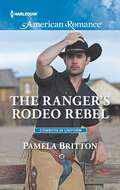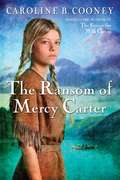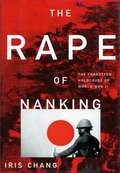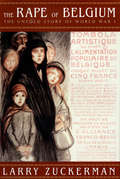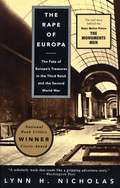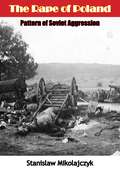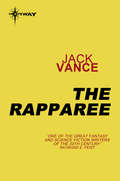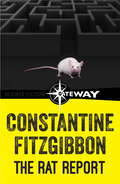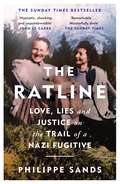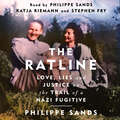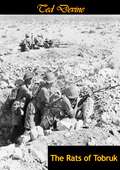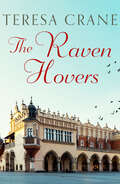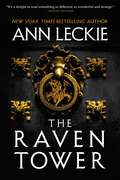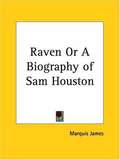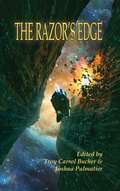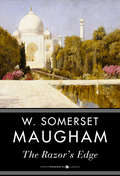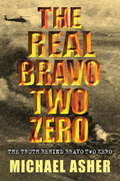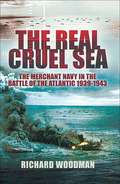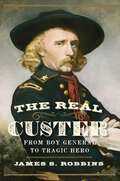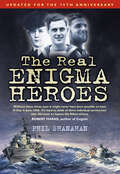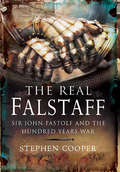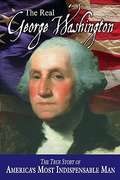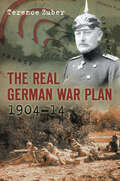- Table View
- List View
The Ranger's Rodeo Rebel
by Pamela BrittonIn July 2016 HARLEQUIN AMERICAN ROMANCE will become HARLEQUIN WESTERN ROMANCE. Same great stories, new name! A PROMISE TO PROTECT Under the guise of taking over the family's rodeo act, former Army Ranger Chance Reynolds is actually home to protect their star trick rider, Carolina Cruthers, from her ex. Keeping an eye on the spunky blonde isn't a problem. Keeping things professional? That's getting harder every day. Though Caro feels safe with Chance, she knows getting involved with her boss would be a bad idea, never mind dragging him into her messy past. But life on the rodeo trail draws them closer, and what started as a short-term arrangement suddenly feels anything but temporary. Can Chance convince Caro that they should team up forever?
The Ransom of Mercy Carter
by Caroline B. CooneyDeerfield, Massachusetts is one of the most remote, and therefore dangerous, settlements in the English colonies. In 1704 an Indian tribe attacks the town, and Mercy Carter becomes separated from the rest of her family, some of whom do not survive. Mercy and hundreds of other settlers are herded together and ordered by the Indians to start walking. The grueling journey -- three hundred miles north to a Kahnawake Indian village in Canada -- takes more than 40 days. At first Mercy's only hope is that the English government in Boston will send ransom for her and the other white settlers. But days turn into months and Mercy, who has become a Kahnawake daughter, thinks less and less of ransom, of Deerfield, and even of her "English" family. She slowly discovers that the "savages" have traditions and family life that soon become her own, and Mercy begins to wonder: If ransom comes, will she take it?From the Hardcover edition.
The Rape Of Nanking: The Forgotten Holocaust Of World War II
by Iris ChangIn December 1937, in what was then the capital of China, one of the most brutal massacres in the long annals of wartime barbarity occurred. The Japanese army swept into the ancient city of Nanking (Nanjing) and within weeks not only looted and burned the defenseless city but systematically raped, tortured, and murdered more than 300,000 Chinese civilians. Amazingly, the story of this atrocity-one of the worst in world history-continues to be denied by the Japanese government.Based on extensive interviews with survivors and newly discovered documents in four different languages (many never before published), Iris Chang, whose own grandparents barely escaped the massacre, has written what will surely be the definitive, English-language history of this horrifying episode-one that the Japanese have tried for years to erase from public consciousness.The Rape of Nanking tells the story from three perspectives: that of the Japanese soldiers who performed it; of the Chinese civilians who endured it; and finally of a group of Europeans and Americans who refused to abandon the city and were able to create a safety zone that saved almost 300,000 Chinese. It was Chang who discovered the diaries of the German leader of this rescue effort, John Rabe, whom she calls the "Oskar Schindler of China." A loyal supporter of Adolf Hitler but far from the terror planned in his Nazi-controlled homeland, he worked tirelessly to save the innocent from slaughter.But this book does more than just narrate details of an orgy of violence; it attempts to analyze the degree to which the Japanese imperial government and its militaristic culture fostered in the Japanese soldier a total disregard for human life.Finally, it tells one more shocking story: Despite the fact that the death toll at Nanking exceeded the immediate deaths from the atomic blasts at Hiroshima and Nagasaki combined (and even the total wartime casualty count of entire European countries), the Cold War led to a concerted effort on the part of the West and even the Chinese to court the loyalty of Japan and stifle open discussion of this atrocity. Indeed, Chang characterized this conspiracy of silence, which persists to this day, as "a second rape."
The Rape of Belgium
by Larry ZuckermanIn August 1914, the German Army invaded the neutral nation of Belgium, violating a treaty that the German chancellor dismissed as a "scrap of paper." The invaders terrorized the Belgians, shooting thousands of civilians and looting and burning scores of towns, including Louvain, which housed the country's preeminent university. The Rape of Belgium recalls the bloodshed and destruction of the 1914 invasion, and the outrage it inspired abroad. Yet Larry Zuckerman does not stop there, and takes us on a harrowing journey over the next fifty months, vividly documenting Germany's occupation of Belgium. The occupiers plundered the country, looting its rich supply of natural resources; deporting Belgians en masse to Germany and northern France as forced laborers; and jailing thousands on contrived charges, including the failure to inform on family or neighbors. Despite the duration of the siege and the destruction left in its wake, in considering Belgium, neither the Allies nor the history books focused on the occupation, and instead cast their attention almost wholly on the invasion. Now, The Rape of Belgium draws on a little-known story to remind us of the horrors of war. Further, Zuckerman shows why the Allies refrained from punishing the Germans for the occupation and controversially suggests that had the victors followed through, Europe's reaction to the rise of Nazi Germany might have taken a very different course.
The Rape of Europa: The Fate of Europe’s Treasures in the Third Reich and the Second World War
by Lynn H. NicholasWinner of the National Book Critics Circle Award. The cast of characters includes Hitler and Goering, Gertrude Stein and Marc Chagall--not to mention works by artists from Leonardo da Vinci to Pablo Picasso. And the story told in this superbly researched and suspenseful book is that of the Third Reich's war on European culture and the Allies' desperate effort to preserve it. From the Nazi purges of "Degenerate Art" and Goering's shopping sprees in occupied Paris to the perilous journey of the Mona Lisa from Paris and the painstaking reclamation of the priceless treasures of liberated Italy, The Rape of Europa is a sweeping narrative of greed, philistinism, and heroism that combines superlative scholarship with a compelling drama. "Nicholas knows the art world as well as any military historian knows his battlefield. ... Her work deserves the widest reading."--New York Times Book Review.
The Rape of Poland: Pattern of Soviet Aggression
by Stanislaw MikolajczykFirst published in 1948, this is the inside story by the former head of the Polish Government in Exile, and more recently head of the Peasants’ Party in Poland, which tried to find a way to co-operate with the Soviets.“A raging question in Poland has become, ‘How long will it take them to communize us completely?’“To my mind, however, the question is badly framed. I am convinced that human beings cannot be converted to communism if that conversion is attempted while the country concerned is under Communist rule. Under Communist dictatorship the majority become slaves—but men born in freedom, though they may be coerced, can never be convinced. Communism is an evil which is embraced only by fools and idealists not under the actual heel of such rule.“The question should be phrased: How long can a nation under Communist rule survive the erosion of its soul?”—Stanislaw Mikolajczyk, Preface
The Rapparee
by Jack VanceThe Rapparee is Jack Vance's preferred title for the novel previously published as The Space Pirate and The Five Gold Bands.Five gold bracelets imprinted with cryptic messages were the clues that set Paddy Blackthorn off on a riotous galactic treasure hunt. But Paddy found himself not only the hunter but also the hunted for the armbands had been left to him by his would-be killers, the Rulers of the Five Planets.All Jack Vance titles in Gateway use the author's preferred texts, as restored for the Vance Integral Edition (VIE), an extensive project masterminded by an international online community of Vance's admirers. In general, we also use the VIE titles, and have adopted the arrangement of short story collections to eliminate overlaps.
The Rat Report
by Constantine FitzgibbonA rat called Crocus, imprisoned in the laboratory of an Irish scientist Dr Dresmond Burke, is transmitting information to a person or persons unknown in another galaxy. His information is in the form of a report on man's history and development over the past 500 years. And it ends with Crocus's shadowy imprecise foreknowledge of what will become of the human race in the future.Crocus is sharp, wise and cleverer by far than most men - as, he claims, the whole race of rats is. He comments astutely on man's spiritual decline; on the collapse of formalised religion and the obsession with things scientific; with man's mistakes in numerology, and therefore in mathematics and astronomy; and with his loss of faith in all that is supernatural or extra-sensory. But Crocus himself is being monitored by Dr Burke, who is beaming the rat's thoughts through an elderly lady medium and on to a tape recorder. The message as transmitted is unintelligible, but Dr Burke thinks he knows a way to interpret it. This involves outside help...the help of the army...of foreign powers. And then he discovers that what he has learned through Crocus is already known to a small band of resolute and dedicated men. Man's thought-processes can be interfered with, thought-waves can move material objects, and this knowledge is being put to a use more potent than the nuclear bomb...
The Rat Report
by Constantine FitzgibbonA rat called Crocus, imprisoned in the laboratory of an Irish scientist Dr Dresmond Burke, is transmitting information to a person or persons unknown in another galaxy. His information is in the form of a report on man's history and development over the past 500 years. And it ends with Crocus's shadowy imprecise foreknowledge of what will become of the human race in the future.Crocus is sharp, wise and cleverer by far than most men - as, he claims, the whole race of rats is. He comments astutely on man's spiritual decline; on the collapse of formalised religion and the obsession with things scientific; with man's mistakes in numerology, and therefore in mathematics and astronomy; and with his loss of faith in all that is supernatural or extra-sensory. But Crocus himself is being monitored by Dr Burke, who is beaming the rat's thoughts through an elderly lady medium and on to a tape recorder. The message as transmitted is unintelligible, but Dr Burke thinks he knows a way to interpret it. This involves outside help...the help of the army...of foreign powers. And then he discovers that what he has learned through Crocus is already known to a small band of resolute and dedicated men. Man's thought-processes can be interfered with, thought-waves can move material objects, and this knowledge is being put to a use more potent than the nuclear bomb...
The Ratline: Love, Lies and Justice on the Trail of a Nazi Fugitive
by Philippe Sands*THE SUNDAY TIMES BESTSELLER* FROM THE AUTHOR OF EAST WEST STREETAs Governor of Galicia, SS Brigadeführer Otto Freiherr von Wächter presided over an authority on whose territory hundreds of thousands of Jews and Poles were killed, including the family of the author's grandfather. By the time the war ended in May 1945, he was indicted for 'mass murder'. Hunted by the Soviets, the Americans, the Poles and the British, as well as groups of Jews, Wächter went on the run. He spent three years hiding in the Austrian Alps, assisted by his wife Charlotte, before making his way to Rome where he was helped by a Vatican bishop. He remained there for three months. While preparing to travel to Argentina on the 'ratline' he died unexpectedly, in July 1949, a few days after spending a weekend with an 'old comrade'.In The Ratline Philippe Sands offers a unique account of the daily life of a senior Nazi and fugitive, and of his wife. Drawing on a remarkable archive of family letters and diaries, he unveils a fascinating insight into life before and during the war, on the run, in Rome, and into the Cold War. Eventually the door is unlocked to a mystery that haunts Wächter's youngest son, who continues to believe his father was a good man - what happened to Otto Wächter, and how did he die? *** 'A gripping adventure, an astounding journey of discovery and a terrifying and timely portrait of evil in all its complexity, banality, self-justification and madness. A stunning achievement' STEPHEN FRY 'Hypnotic, shocking and unputdownable' JOHN LE CARRÉ'Breathtaking, gripping, and ultimately, shattering. Philippe Sands has done the unimaginable: look a butcher in the eye and tell his story without flinching' ELIF SHAFAK'A triumph of research and brilliant storytelling' ANTONY BEEVOR
The Ratline: Love, Lies and Justice on the Trail of a Nazi Fugitive
by Philippe Sands*FROM THE BESTSELLING AUTHOR OF EAST WEST STREET* As Governor of Galicia, SS Brigadeführer Otto Freiherr von Wächter presided over an authority on whose territory hundreds of thousands of Jews and Poles were killed, including the family of the author's grandfather. By the time the war ended in May 1945, he was indicted for 'mass murder'. Hunted by the Soviets, the Americans, the Poles and the British, as well as groups of Jews, Wächter went on the run. He spent three years hiding in the Austrian Alps, assisted by his wife Charlotte, before making his way to Rome where he was helped by a Vatican bishop. He remained there for three months. While preparing to travel to Argentina on the 'ratline' he died unexpectedly, in July 1949, a few days after spending a weekend with an 'old comrade'.In The Ratline Philippe Sands offers a unique account of the daily life of a senior Nazi and fugitive, and of his wife. Drawing on a remarkable archive of family letters and diaries, he unveils a fascinating insight into life before and during the war, on the run, in Rome, and into the Cold War. Eventually the door is unlocked to a mystery that haunts Wächter's youngest son, who continues to believe his father was a good man - what happened to Otto Wächter, and how did he die? *** 'A gripping adventure, an astounding journey of discovery and a terrifying and timely portrait of evil in all its complexity, banality, self-justification and madness. A stunning achievement' STEPHEN FRY 'Hypnotic, shocking and unputdownable' JOHN LE CARRÉ'Breathtaking, gripping, and ultimately, shattering. Philippe Sands has done the unimaginable: look a butcher in the eye and tell his story without flinching' ELIF SHAFAK'A triumph of research and brilliant storytelling' ANTONY BEEVOR
The Rats of Tobruk
by John Berchmans DevineTHIS is the personal record of nine months spent as a medical officer on active service in Libya. Its purpose is to endeavour to show what a great warrior the ordinary Australian soldier really is, and with what light-hearted bravery and endurance he faces up to discomfort and death. It is written as a personal record to gain continuity, and always in the spirit of an onlooker who sees much of the play. It is neither a scientific document nor history, and I cannot vouch for the accuracy of many of the stories set down herein, but even if they are not wholly true, they are still characteristic. No names are included, and it is purely coincidental that most of the happenings herein described are fact and not fiction.Some of the illustrations are taken from drawings and oil sketches made by the author on the spot, and the remainder are photographs taken with a miniature camera and developed in Tobruk. "Major Devine's little volume of personal experiences brings the whole picture of the dust and desert, of stone and rock, of battered equipment, of patient endurance, back before one's eyes. It translates into human individual terms all the planning and endeavour and struggle that characterized the splendid defence of Tobruk by our own 9th Australian Division and by other British troops from the United Kingdom and troops from India who were there with them in that epic siege."--T. A. Blamey General, Commander-in-Chief, Australian Military Forces (Foreword to "The Rats of Tobruk")
The Raven Hovers
by Teresa CraneTwo brothers, an epic conflict and a dark family secret. An extraordinary novel from Teresa Crane, author of the bestselling The Italian HouseStefan and Marik Anderson: two men bound together by blood and divided by a hatred sown since birth... Stefan, the illegitimate outcast, has lived a tough and difficult life on the wild Essex marshes: Marek, diffident and intelligent, has been brought up in easy and affluent London.It is only with the outbreak of the Second World War that their lives change. As the conflict rages around them Stefan, a hero of the Polish partisan movement, and Marek reluctantly embark on a secret mission to support the cause and uncover the Nazi’s ‘retailiation weapon’. Yet still the bitter past is a source of discord.Danusia, Stefan's lover and fellow freedom-fighter is startled and intrigued by their enmity. And it is to Marek she confides a secret that she knows will cost her her life if Stefan should discover it...A novel of war, love and desperate secrets, The Raven Hovers will keep you gripped until the very end. Perfect for fans of Kate Morton, Katie Fforde and Nicola Cornick.
The Raven Tower
by Ann LeckieGods meddle in the fates of men, men play with the fates of gods, and a pretender must be cast down from the throne in this masterful first fantasy novel from Ann Leckie, New York Times bestselling author and winner of the Hugo, Nebula, and Arthur C. Clarke Awards. For centuries, the kingdom of Iraden has been protected by the god known as the Raven. He watches over his territory from atop a tower in the powerful port of Vastai. His will is enacted through the Raven's Lease, a human ruler chosen by the god himself. His magic is sustained via the blood sacrifice that every Lease must offer. And under the Raven's watch, the city flourishes.But the power of the Raven is weakening. A usurper has claimed the throne. The kingdom's borders are tested by invaders who long for the prosperity that Vastai boasts. And they have made their own alliances with other gods.It is into this unrest that the warrior Eolo--aide to Mawat, the true Lease--arrives. And in seeking to help Mawat reclaim his city, Eolo discovers that the Raven's Tower holds a secret. Its foundations conceal a dark history that has been waiting to reveal itself...and to set in motion a chain of events that could destroy Iraden forever.
The Raven: A Biography of Sam Houston
by Marquis JamesThis work tells the tale of Sam Houston: United States Senator; military hero; protégé of Andrew Jackson and Tennessee's Young Man of Destiny; General and President of the Texas Republic; Ambassador of the Cherokee Nation of Indians and adoptee of the Cherokee people; and as trouble brewed with Mexico, he was chosen commander in chief of the Texan provisional government.<P><P> Pulitzer Prize Winner
The Razor's Edge
by Steve Perry Sharon Lee Steve Miller Kay Kenyon William C. Dietz Walter H. Hunt L. E. Modesitt Joshua Palmatier Gerald Brandt Seanan McGuire D. B. Jackson Troy Carrol Bucher Blake Jessop Sharon P. Goza Christopher Allenby Chris Kennedy Alex Gideon Brian Hugenbruch Y. M. PangOne man’s insurgent is another man’s freedom fighter… From The Moon is a Harsh Mistress to The Hunger Games, everyone enjoys a good rebellion. There is something compelling about a group (or individual) who throws caution to the wind and rises up in armed defiance against oppression, tyranny, religion, the government—you name it. No matter the cause, or how small the chance, it’s the courage to fight against overwhelming odds that grabs our hearts and has us pumping our fists in the air. Win or lose, it’s the righteous struggle we cherish, and those who take up arms for a cause must walk The Razor’s Edge between liberator and extremist.With stories by Blake Jessop, William C. Dietz, D.B. Jackson, Gerald Brandt, Sharon P. Goza, Walter H. Hunt, Sharon Lee & Steve Miller, Kay Kenyon, Steve Perry, Seanan McGuire, Christopher Allenby, Chris Kennedy, L.E. Modesitt, Jr., Alex Gideon, Brian Hugenbruch, and Y.M. Pang.
The Razor's Edge (Vintage International Ser.)
by W. MaughamAlthough Larry Darrell has returned home safely from active duty as a pilot in the Great War, his experiences have left him raw and traumatized. Seeing the world from a much different perspective than he had before the War, Larry sets out on a journey to find peace and a deeper meaning in his life, rejecting the conventionality that his friends and loved ones seem to embrace.The Razor’s Edge quickly became a bestseller upon its publication in 1944, and was one of the first books to foreshadow the popularization of Eastern philosophy and spirituality in Western culture.HarperPerennial Classics brings great works of literature to life in digital format, upholding the highest standards in ebook production and celebrating reading in all its forms. Look for more titles in the HarperPerennial Classics collection to build your digital library.
The Real Bravo Two Zero
by Michael AsherThe true story of the most famous SAS operation in history.'Bravo Two Zero' was the code-name of the famous SAS operation: a classic story of bravery in the face of overwhelming odds. BRAVO TWO ZERO by patrol commander 'Andy McNab' became an international bestseller, as did the book by 'Chris Ryan' (THE ONE THAT GOT AWAY). Both men became millionaires. Three members of the patrol were killed. One, veteran sergeant Vince Phillips, was blamed in both books for a succession of mistakes. As Michael Asher reveals, the stories in BRAVO TWO ZERO and THE ONE THAT GOT AWAY grew considerably in the telling. Their heroic tales of taking out tanks with their rocket launchers, mowing down hundreds of Iraqi soldiers, the silent stabbing of the occasional sentry, were never mentioned at their post-war debriefings... In an investigation literally in the footsteps of the patrol, Michael Asher tells the true story.
The Real Bravo Two Zero
by Michael AsherThe true story of the most famous SAS operation in history.'Bravo Two Zero' was the code-name of the famous SAS operation: a classic story of bravery in the face of overwhelming odds. BRAVO TWO ZERO by patrol commander 'Andy McNab' became an international bestseller, as did the book by 'Chris Ryan' (THE ONE THAT GOT AWAY). Both men became millionaires. Three members of the patrol were killed. One, veteran sergeant Vince Phillips, was blamed in both books for a succession of mistakes. As Michael Asher reveals, the stories in BRAVO TWO ZERO and THE ONE THAT GOT AWAY grew considerably in the telling. Their heroic tales of taking out tanks with their rocket launchers, mowing down hundreds of Iraqi soldiers, the silent stabbing of the occasional sentry, were never mentioned at their post-war debriefings... In an investigation literally in the footsteps of the patrol, Michael Asher tells the true story.
The Real Cruel Sea: The Merchant Navy in the Battle of the Atlantic, 1939–1943
by Richard WoodmanThe renowned maritime historian&’s compelling study of the vital role played by merchant seamen during WWII in the Battle of the Atlantic. For the British, the Battle of the Atlantic was a fight for survival. They depended on the safe transit of hundreds of merchant ships carrying food and supplies from America to feed the country and keep the war effort going. On top of that, they had to export manufactured goods to pay for it all. Britain's merchant navy, a disparate collection of private vessels, had become the country's lifeline. While its seamen were officially non-combatants, they bravely endured the onslaught of the German U-boat offensive until Allied superiority overwhelmed the enemy. Drawing extensively on first-hand sources, Richard Woodman establishes the importance of the British and Allied merchant fleets in the struggle against Germany. This important study elevates the heroic seamen who manned these ships to their rightful place in the history of the Second World War.
The Real Custer: From Boy General to Tragic Hero
by James S RobbinsThe Real Custer takes a good hard look at the life and storied military career of George Armstrong Custer--from cutting his teeth at Bull Run in the Civil War, to his famous and untimely death at Little Bighorn in the Indian Wars. <P><P>Author James Robbins demonstrates that Custer, having graduated last in his class at West Point, went on to prove himself again and again as an extremely skilled cavalry leader. Robbins argues that Custer's undoing was his bold and cocky attitude, which caused the Army's bloodiest defeat in the Indian Wars. <P><P>Robbins also dives into Custer's personal life, exploring his letters and other personal documents to reveal who he was as a person, underneath the military leader. The Real Custer is an exciting and valuable contribution to the legend and history of Custer that will delight Custer fans as well as readers new to the legend.
The Real Enigma Heroes
by Phil ShanahanFor almost sixty years after their deaths, three men, whose brave actions shortened the Second World War by as much as two years, remained virtually unknown and uncelebrated. Two lost their lives retrieving vital German codebooks from a sinking U-boat. The third survived the war, only to die in a house fire soon afterwards. But it was the precious documents they seized in October 1942 that enabled Bletchley Park’s code-breakers to crack Enigma and so win the Battle of the Atlantic. Now recognised as a pivotal moment in world history, three British servicemen made it possible to finally beat the U-boats, but at the time not even their families could be told of the importance of their deeds. Shrouded in secrecy for decades, then recast as fictional Americans by the Hollywood film U-571, this book sets the record straight. It is written in celebration of Colin Grazier GC, Tony Fasson GC, and Tommy Brown GM - the REAL Enigma heroes.
The Real Falstaff: Sir John Fastolf and the Hundred Years War
by Stephen CooperThis historical study examines the life and military accomplishments of the medieval knight who inspired one of Shakespeare&’s most beloved characters. One of the most famous English knights of the Hundred Years War, Sir John Fastolf is widely thought to be a model for Shakespeare&’s immortal character, Sir John Falstaff. In The Real Falstaff, historian Stephen Cooper examines the link in full, shedding light on his story as well as the declining English fortunes during the last phase of the Hundred Years War. Witnessing both the triumphs of Henry V, and the disasters of the 1450s, Fastolf was one of the last of the brave but often brutal English soldiers who made their careers waging war in France. Cooper retraces the entire course of Fastolf&’s long life, putting special focus on his many campaigns. A vivid picture of the old soldier emerges and of the French wars in which he played such a prominent part. But the author also explores Fastolf&’s legacy, his connection to the Paston family—famous for the Paston letters—and the use Shakespeare made of Fastolf&’s name, career, and character when he created Sir John Falstaff.
The Real George Washington (American Classic Series)
by Jay A. Parry Andrew M. AllisonWhy, after two centuries, does George Washington remain one of the most beloved figures in our history? The Real George Washington Answers that question by giving us a close look at this man who became the "father of our country" and the first American President. But rather than focus on the interpretations of historians, the book tells much of his exciting story in his own words. In Part I you'll meet a man who *lost his father at age 11 and nearly joined the British navy at 15. *was ambushed in the French and Indian War, receiving bullets through his coat and hat but escaping without injury. *held together a destitute army through the long and terrible winter at Valley Forge. *resisted plans to make him king and an army plot to take over the government. *made the Constitutional Convention credible by his presence and helped win ratification of the Constitution by his support. *sacrificed his desire for a quiet retirement to serve as the first President, and, while serving, set a valuable precedent of constitutional governance. Part II of the book brings together the most important and insightful passages from Washington's writings, conveniently arranged in alphabetical order by subject matter.
The Real German War Plan, 1904-14
by Terence ZuberThe Real German War Plan 1904-14 fundamentally changes our understanding of German military planning before the First World War. On the basis of newly discovered or long-neglected documents in German military archives, this book gives the first description of Schlieffen's war plans in 1904 and 1905 and Moltke's plans from 1906 to 1914. It explodes unfounded myths concerning German war planning, gives the first appraisal of the actual military and political factors that influenced it, proves conclusively that there never was a 'Schlieffen Plan' and reveals Moltke's strategy for a war against Russia from 1909 to 1912. Tracing the decline in the German military position and the recognition by 1913 that Germany would be forced to fight outnumbered on both the eastern and western fronts, it is an essential read for anyone with an interest in the First World War.
